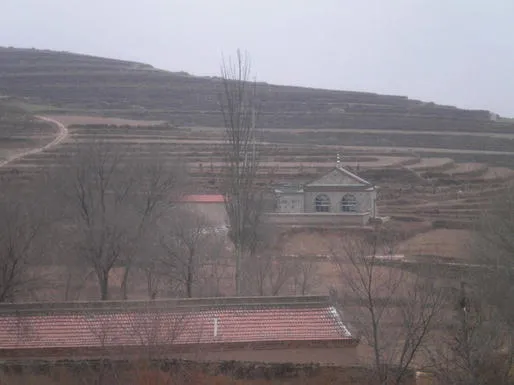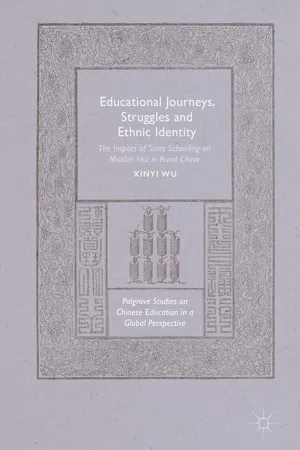The bus carefully passes through and makes its rough turns alongside the rugged mountains. As soon as the winding road ends, it is broadened up and leads further to a land of barrenness with small villages remotely scattered where mosques are seen standing in the middle of the harsh landscape and nestled at the foot of mountains, far away from the main road but glittering at passersby with their shiny crescent moons and stars on the top.
Gongbeis, or enshrined tombs, are built magnificently containing the remains of spiritual Islamic heroes or founders of various sects, stretching a few blocks in villages;
Qingzhen (
Halal)
restaurants line the streets of counties and township, decorated with boards written
Tasmi in Arabic scripts that read, “In the name of God, the most gracious, the most merciful.” Images of Al-Masjid Al-Haram, the Sacred Mosque or the Grand Mosque in the city of Mecca, are hung up on the walls, while
Hancan (non-
Halal) restaurants are nearly invisible. Men and women are often seen in white hats and colorful headscarves on their scooters and bicycles or driving small trucks and vans. This wide space is called
Xihaigu , a name unknown to many Chinese people, but a place that generations of Muslim Hui call home. In the past, accessing this heartland of northwestern China is nearly impossible. Today, it is still not easy to access, even with regular bus and train schedules and asphalt-paved roads. It requires an approximate four-hour bus ride from Yinchuan, the capital city of
Ningxia Autonomous Region, or an eight-hour bus ride from Xi’an, the capital city of Shaanxi, to reach a main county center in the area, and it takes another hour or more to get to the towns and villages within the county. There is still no high-speed train stopping by the
Guyuan City where the nearest train station is located; with slow trains occasionally make their stops in
Guyuan, getting from the train station to any parts of county still needs hours more of traveling (Fig.
1.1).
Xihaigu is a mountainous area in the southern Ningxia autonomous region. This extended mountainous region is shaped as a turtle, surrounded by Gansu province on the southwest with six counties in Guyuan city , and Yinchi and Tongxin counties of Wuzhong city of Ningxia. Located on the Loess Plateau and the Silk Road , it was historically an important hub for importing and exporting trades, where many Muslim traders finally settled and integrated into Chinese society. Xihaigu is also the place where the culture of pastoralism from the north interacted and integrated with the culture of farming in the central plain. Local farmers rely heavily on crop farming and livestock husbandry with some households engaged in large-scale commercial agriculture . Because the region has been geographically isolated by layers of mountains without a sufficiently developed transportation system, it faces considerably slow economic development compared to rapid national development in China in recent years (Xu, 2012). However, Islamic practices are prevalent, as it is the core component of local Muslim Hui life. Households in villages are usually built around mosques where religious activities are conducted, through which jiaofang , the religious communities, are formed and maintained (Ma, 2008).
In 1972, Xihaigu was listed as one of the world’s most uninhabitable zones by the United Nations World Food Program. Year-round drought makes it difficult for many crops to grow except potatoes, corn, and flax; and overly grazed grassland leads to depletion and erosion of the soil. In some remote mountainous regions , drinking water simply is not available, and people have to walk miles to fetch water for daily needs (Zhu & Chiang, 1996). Such chronic water shortages and harsh natural environment are ever-present threats (Chinadaily, 2013), which cause many people to live in poverty , barely making ends meet. Since 1978, influenced by the strong push for economic development initiated with the Open Door Policy , the Chinese government has invested large amounts of money on Xihaigu in an attempt to lift people out of poverty . A series of poverty-reduction initiatives was carried out to stimulate local economic development. One of the important tasks was to preserve water resources and build infrastructure to obtain water from underground or other regions for the purposes of farming irrigation and daily necessity. More roads started being built, linking villages to townships and nearby cities in the hope of providing local people with access to outside opportunities. While crop farming and livestock husbandry are still two dominant ways of living, local governments have started to promote farming industry, forestry, and family businesses, and encourage people to return the farmland to growing trees (Tuigenhuanlin 退耕还林). More villagers receive financial incentives to grow commercial crops and raise livestock in addition to the traditional subsistence agriculture . A series of social policies were also implemented to assist local farmers not only to survive but also to live a better life. For example, each household was provided with skills and literacy training so that at least one laborer from each household could have the skills to find non-farming jobs. Free TV dishes were installed for every family so that they could have access to outside information and resources. Solar cookers were also introduced to most families and installed with government subsidies. “Immigrant villages” were recently established to move villagers from the remote mountainous regions to designated places near townships and counties, and provide residents with free housing and other necessary supplies. Although these poverty-reduction initiatives have helped a large number of local households live better, poverty is still persistent, especially in the remote mountainous regions , largely due to the population explosion in the 1970s and 1980s, limited natural resources, the harsh environment and frequent natural disasters, and predominant dependence on agriculture.
Economic development triggers social changes. The rural residents of Xihaigu started to experience an unprecedented transformation from a traditional society to a modern society, and they were forced into a transitioning period, during which they needed to seek alternatives for poverty alleviation. Some were not prepared to respond to the sudden change and still considered farming a primary source of income with complementary part-time and off-season, labor-centric work in local areas or nearby provinces; whereas others saw the opportunities outside villages for non-agriculture jobs and decided to migrate to other provinces for high-income jobs. Since 1985, single males constituted the majority of migrant workers , and they replaced the older major laborers, who previously earned extra income for the family. Starting in 1994, the idea of being a migrant worker swept through villages, and more and more local farmers chose to leave farmland for urban factories and the service sector. A diverse group of migrants, both old and young, have emerged (Chen, 2002).
Responding to economic development and the social transformation of local communities, four major social classes have appeared. The middle-upper class consists of county and township government officials, skilled workers, private business owners, and religious personnel. The middle class contains village managerial staff and small business owners. The middle lower class usually refers to farmers, loiterers, and anyone who is able to work but is not employed. The last group is migrant workers who constantly switch from labor-centric work in the city to farming work back in the village during harvest season (Zhang, 2006). The increasing complexity of social stratification leads to Muslim Hui’s discrepant perceptions of education, as the new social stratification seems associated with levels of education and corresponding employments. Therefore, education has gradually been valued as a viable pathway to achieving prosperity and acquisition of high economic and social status.
Muslim Hui in China, Ningxia, and Xihaigu
The Muslim Hui population is approximately 10 million across China based on the data from the sixth national population census (National Bureau of Statistics of China, 2010). As the second largest ethnic group, its members are both concentrated in certain ethnic minority regions and scattered through all provinces, municipalities, and autonomous regions (State Ethnic Affairs Commission of People’s Republic of China, n.d.). According to Yang (2006), Muslim Hui people on the east coast occupy 21.05% of the total Hui population in China; Hui members in the middle regions account for another 18.21%; and the majority of the Hui population (60.75%) resides in western China. In northwestern China, the Muslim Hui are mostly concentrated, as opposed to their counterparts scattered along the eastern coast. The Ningxia Hui autonomous region, located in northwestern China, was established in 1958 and is the designated provincial-level region for Muslim Hui. There, the Hui population occupied 35% of the total regional population in 2010 (Ningxia Statistics Bureau, 2011), and with large numbers considering Xihaigu home.
Because the Muslim Hui reside in diverse parts of China, they express a wide spectrum of
ethnoreligious identities influenced by their social and political environments
(Gladney,
2004). For example, in urban areas, many Muslim Hui do not equate their ethnic category with a religious affiliation, and they are often difficult to identify by the ways in which they practice Islam. In some regions, occupational specializations, such as small restaurant business owners, and dietary restrictions may indicate the Muslim Hui; however, among Muslim Hui who follow dietary restrictions, the practice of consuming only
Halal food also differs across different Muslim communities
(Gladney,
1991). Because Ningxia Hui Autonomous Region has the most concentrated Muslim Hui population, Muslim Hui express a strong Hui identity through exhibiting their Islamic beliefs and actively participating in religious
rituals (Gladney,
1991).
By 1997, the total population in Ningxia was about 2,360,000, and Muslim Hui represented 45%. In some counties, Muslim Hui occupy over 90%, such as some towns and villages in Xihaigu. Such high concentration of Muslim Hui has created a landscape where Hui is culturally
dominant and Han are the perceived minority (Fig.
1.2).
Although Muslim Hui express a wide spectrum of ethnoreligious identities across China, Muslim Hui in Xihaigu are among the most conservative ones. They not only follow strict dress customs and dietary restrictions, but also actively engage in a variety of religious rituals , both at home and in the community, such as fulfilling five pillars of Islam and observing holidays according to the Islamic calendar. As a tradition, Muslim men and women are required to wear white hats and cover their heads with colorful headscarves, and they do not take them off except when they go to sleep. Boys and girls who attend mosque education to learn Koranic texts also wear white hats and colorful headscarves to show their statuses as Manla, apprentices of Ahongs (Imams) of mosques. In contrast, people rarely wear sleeveless shirts, shorts, or skirts, as overexposure of the skin in public is culturally unacceptable. Although I, as an urban Muslim Hui, was not expected to dress alike, I was reminded by my local Muslim Hui friends that I needed to keep long pants and long-sleeved shirts handy in case I was invited to events at the mosques or casual meetings with local Muslim...




